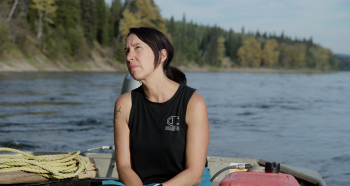Image Caption
Local Journalism Initiative Reporter
Windspeaker.com
When Stellat’en First Nation filmmaker Lyana Patrick was invited to become involved in a film project in British Columbia she jumped at the opportunity.
That’s because the film’s focus was on the decades-long struggle by her own First Nation against the disruption of an important river.
Patrick is days away now from the world premiere of the feature documentary she directed titled Nechako: It Will Be a Big River Again. The film will be screened for the first time in Vancouver on May 3 at the DOXA Documentary Film Festival.
The documentary chronicles the challenges that her Nation and neighbouring Saik’uz First Nation have endured since the Kenney Dam was built in the 1950s.
Construction of the dam diverted 70 per cent of the Nechako River into an artificial reservoir, severely hindering the lives of members of the two First Nations. With portions of the river drying up, it drastically decreased the Nations’ main food source of fish.
In the seven decades since the dam’s construction there have been various legal battles, which are ongoing, against the governments of B.C., Canada and Rio Tinto Alcan, a subsidiary of a leading mining company.
“I really hope that people are drawn to action of some sort,” said Patrick, who now lives in Vancouver. “I think what the film really is trying to portray is the importance of Indigenous stewardship.”
Saik'uz First Nation Chief Priscilla Mueller first brought up the idea of making a film about efforts to protect the Nechako River. At the time, a court case was about to be heard in B.C. Supreme Court.
“They were in the midst of that court battle, which the film documents, and (the chief) really wanted to bring this story to a big audience,” Patrick said. “And she suggested that a film would be a good way to do that.”
Since the film’s topic involved her own First Nation, Patrick was aware of some of the background details. Plus, she had covered parts of the story before in her previous career working as a journalist.
In the mid-1990s, she was a reporter for the British Columbia-based Native Voice newspaper. During this time she covered the Aluminum Company of Canada (Alcan) and its quest to divert the Nechako River to benefit its aluminum smelter.
“This was an intensely personal story, as I knew many of the people who opposed the hydroelectric project and the company’s ongoing attempt to divert yet more of the river into the reservoir behind the Kenney Dam,” Patrick said in her director’s statement for the film. “It would take many years for me to fully understand how the dam impacted my Nation.”
Patrick said Stellat’en First Nation members rely on the river.
“Our identity and connection to place is inscribed in the rushing waters of the Nechako, or ‘Big River’,” she said. “The destruction of the Nechako created conditions for a multi-generational fight from which there is no backing down.”
Patrick herself is a bit surprised she has now made a film about a story she covered more than three decades ago.
“It's an interesting thing that I seem to be drawn to these stories and telling these stories,” she said.
Patrick believes her film will be well received.
“To be honest, this kind of story is a very regional story, which I personally think has much larger implications,” she said. “I think it's a pretty global story about the climate crisis and struggle. I think it can be a tough sell in major centres of the country.
“But I think that where we're going to have a really strong audience is in the smaller cities and towns where I think people will recognize these stories and what's been going on for many decades. So, I think it's going to have a really strong educational component.”
Tickets for the world premiere of Patrick's film at DOXA have been sold out. As a result festival organizers added a second screening on May 9. Tickets are available here https://doxa2025.eventive.org/schedule/680938768c0b5169f357e2f0
The goal is to have the documentary screened at other upcoming festivals as well.
And it is expected to start screening on the National Film Board of Canada (NFB) website this fall. NFB is a co-producer of the film. Lantern Films and Experimental Forest Films also helped to produce the movie.
Local Journalism Initiative Reporters are supported by a financial contribution made by the Government of Canada.

